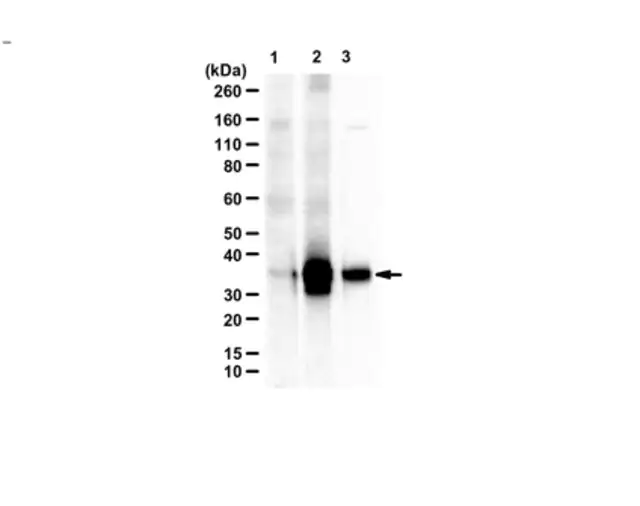您的位置:首页 > 产品中心 > Anti-C9ORF72/C9RANT (poly-PA)
Anti-C9ORF72/C9RANT (poly-PA)

产品别名
Anti-C9ORF72/C9RANT (poly-PA)
C9ORF72/C9RANT (poly-PA), alpha-PA-antisense
基本信息
| eCl@ss | 32160702 |
| General description【一般描述】 | Expansion of a GGGGCC (G4C2) hexanucleotide repeat sequence in the non-coding region of human chromosome 9 open reading frame 72 or C9orf72 (also known as ALSFTD, FTDALS; Gene ID 203228) is the most common genetic abnormality in familial and sporadic frontotemporal dementia (FTD) and motor neuron disease (MND), with amyotrophic lateral sclerosis (ALS) as the most frequent form. The number of hexanucleotide repeats in the normal population ranges from 2 to 24, whereas up to several thousand repeats (700 - 4,400 repeats) are found in the pathologically expanded allele. Unconventional repeat-associated non-ATG-initiated translation (RANT) of the GGGGCC repeats in the three alternate reading frames from both sense and antisense transcripts generates five types of dipeptide repeat (DPR) protein species, each composed of repeating units of two amino acids, glycine-alanine (GA), glycine-proline (GP), glycine-arginine (GR), alanine-proline (AP), proline-arginine (PR), respectively. The sense transcript (5′-GGGGCC-3′ hexanucleotide repeats) is translated through repeat-associated non-ATG (RAN) translation such that poly- (Gly- Ala), poly-(Gly-Pro), and poly-(Gly-Arg) proteins were produced. The anti-sense transcript (containing 5′-GGCCCC-3′ (G2C4) hexanucleotide repeats is translated through repeat-associated non-ATG (RAN) translation producing poly-(Pro-Ala), poly- (Pro-Arg), poly- (Gly-Pro) proteins. The antisense proteins accumulate in cytoplasmic aggregates in affected brain regions, including the frontal and motor cortex, hippocampus, and spinal cord neurons. |
| Specificity【特异性】 | This polyclonal antibody recognizes C9ORF72/C9RANT (poly-PA). |
| Immunogen【免疫原】 | Epitope: unknown H2N-APAPAPAPAPAPAPACKKKK-amide. |
| Application【应用】 | Anti-C9ORF72/C9RANT (poly-PA), Cat. No. ABN1356, is a highly specific rabbit polyclonal antibody that targets C9ORF72(poly-PA) and has been tested in Dot Blot, Immunofluorescence, Immunohistochemistry, and Western Blotting. Immunofluorescence Analysis: A representative lot detected C9ORF72/C9RANT (poly-PA) in transfected HEK293T Flag-PA cells (Zu, T., et. al. (2013). Proc. Natl. Acad. Sci. USA. 110(51):E4968-77). Immunofluorescence Analysis: A 1:500 dilution from a representative lot detected C9ORF72/C9RANT (poly-PA) in Flag-PA trannsfected HEK293T cells (Courtesy of Dr. Laura P.W. Ranum and Dr. Lien Nguyen from the University of Florida). Western Blotting Analysis: A representative lot detected C9ORF72/C9RANT (poly-PA) in recombinant Protein (Zu, T., et. al. (2013). Proc. Natl. Acad. Sci. USA. 110(51):E4968-77). Immunohistochemistry Analysis: A representative lot detected C9ORF72/C9RANT (poly-PA) in aggregates found in neurons of the CA and DG regions of the hippocampus (Zu, T., et. al. (2013). Proc. Natl. Acad. Sci. USA. 110(51):E4968-77). Dot Blotting Analysis: A representative lot detected C9ORF72/C9RANT (PR-CT) in Dot Blotting applications (Zu, T., et. al. (2013). Proc Natl Acad Sci USA. 110(51):E4968-77). Research Category Neuroscience |
| Quality【质量】 | Evaluated by Western Blotting in lysate from HEK293 cells transfected with Flag-PA. Western Blotting Analysis: A 1:1,000 dilution of this antibody detected C9ORF72/C9RANT (poly-PA) in 10 µL of lysate from HEK293 cells transfected with Flag-PA. |
| Physical form【外形】 | Unpurified Rabbit polyclonal serum with 0.05% sodium azide. |
| Other Notes【其他说明】 | Concentration: Please refer to lot specific datasheet. |
产品性质
| biological source【生物来源】 | rabbit |
| Quality Level【质量水平】 | 100 |
| antibody form【抗体形式】 | serum |
| antibody product type | primary antibodies |
| clone【克隆】 | polyclonal |
| species reactivity | human |
| technique(s) | dot blot: suitable immunofluorescence: suitable immunohistochemistry: suitable western blot: suitable |
| NCBI accession no.【NCBI登记号】 | NP_060795 |
| UniProt accession no.【UniProt登记号】 | Q96LT7 |
| shipped in【运输】 | ambient |
产品说明
| Target description【目标描述】 | ~35 kDa observed. Uncharacterized bands may be observed in some lysate(s). |
| Storage and Stability【储存及稳定性】 | Stable for 1 year at -20°C from date of receipt. Handling Recommendations: Upon receipt and prior to removing the cap, centrifuge the vial and gently mix the solution. Aliquot into microcentrifuge tubes and store at -20°C. Avoid repeated freeze/thaw cycles, which may damage IgG and affect product performance. |
| Disclaimer【免责声明】 | Unless otherwise stated in our catalog or other company documentation accompanying the product(s), our products are intended for research use only and are not to be used for any other purpose, which includes but is not limited to, unauthorized commercial uses, in vitro diagnostic uses, ex vivo or in vivo therapeutic uses or any type of consumption or application to humans or animals. |
安全信息
| Storage Class Code【储存分类代码】 | 12 - Non Combustible Liquids |
| WGK | WGK 1 |





